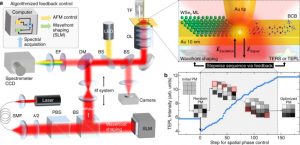Adaptive tip-enhanced nano-spectroscopy
| Reviews and Highlights | Quantum Science | Molecular and Soft-matter | Ultrafast Nano-optics and Nanophotonics | Mineralogy and Geochemistry |
|---|
Dong Yun Lee, Chulho Park, Jinseong Choi, Yeonjeong Koo, Mingu Kang, Mun Seok Jeong, Markus B. Raschke, and Kyoung-Duck Park
Nature Communications 12, 3465 (2021).
DOI PDF SI
 Tip-enhanced nano-spectroscopy, such as tip-enhanced photoluminescence (TEPL) and tip-enhanced Raman spectroscopy (TERS), generally suffers from inconsistent signal enhancement and difficulty in polarization-resolved measurement. To address this problem, we present adaptive tip-enhanced nano-spectroscopy optimizing the nano-optical vector-field at the tip apex. Specifically, we demonstrate dynamic wavefront shaping of the excitation field to effectively couple light to the tip and adaptively control for enhanced sensitivity and polarization-controlled TEPL and TERS. Employing a sequence feedback algorithm, we achieve ~4.4 × 104-fold TEPL enhancement of a WSe2 monolayer which is >2× larger than the normal TEPL intensity without wavefront shaping. In addition, with dynamical near-field polarization control in TERS, we demonstrate the investigation of conformational heterogeneity of brilliant cresyl blue molecules and the controllable observation of IR-active modes due to a large gradient field effect. Adaptive tip-enhanced nano-spectroscopy thus provides for a systematic approach towards computational nanoscopy making optical nano-imaging more robust and widely deployable.
Tip-enhanced nano-spectroscopy, such as tip-enhanced photoluminescence (TEPL) and tip-enhanced Raman spectroscopy (TERS), generally suffers from inconsistent signal enhancement and difficulty in polarization-resolved measurement. To address this problem, we present adaptive tip-enhanced nano-spectroscopy optimizing the nano-optical vector-field at the tip apex. Specifically, we demonstrate dynamic wavefront shaping of the excitation field to effectively couple light to the tip and adaptively control for enhanced sensitivity and polarization-controlled TEPL and TERS. Employing a sequence feedback algorithm, we achieve ~4.4 × 104-fold TEPL enhancement of a WSe2 monolayer which is >2× larger than the normal TEPL intensity without wavefront shaping. In addition, with dynamical near-field polarization control in TERS, we demonstrate the investigation of conformational heterogeneity of brilliant cresyl blue molecules and the controllable observation of IR-active modes due to a large gradient field effect. Adaptive tip-enhanced nano-spectroscopy thus provides for a systematic approach towards computational nanoscopy making optical nano-imaging more robust and widely deployable.
